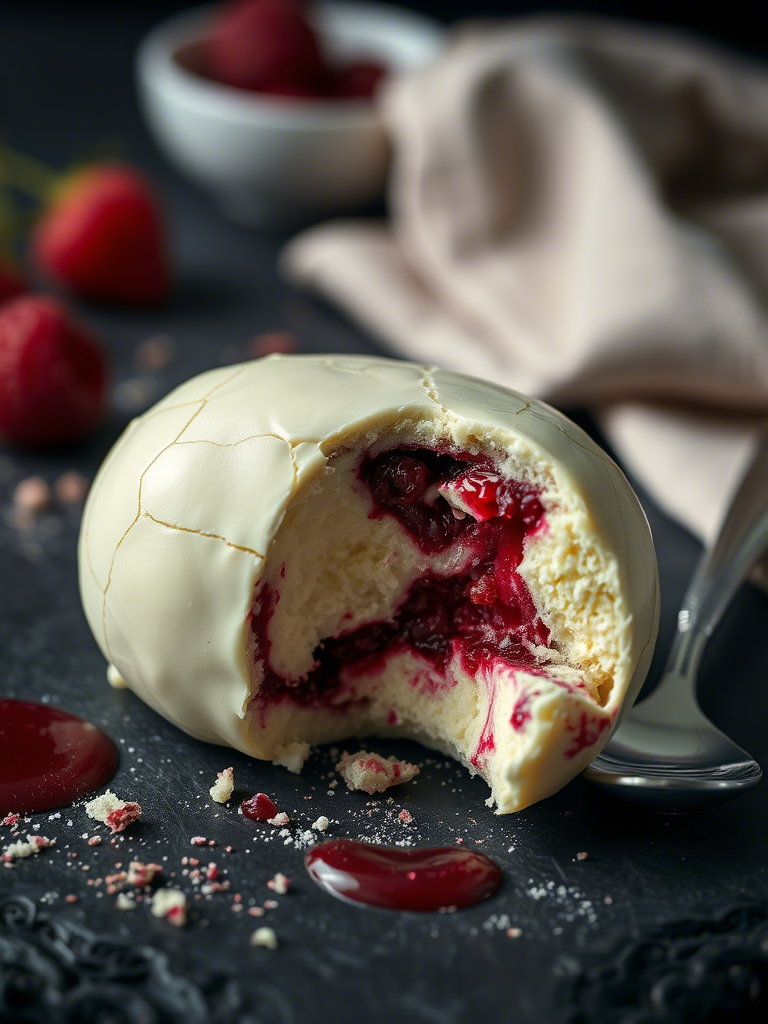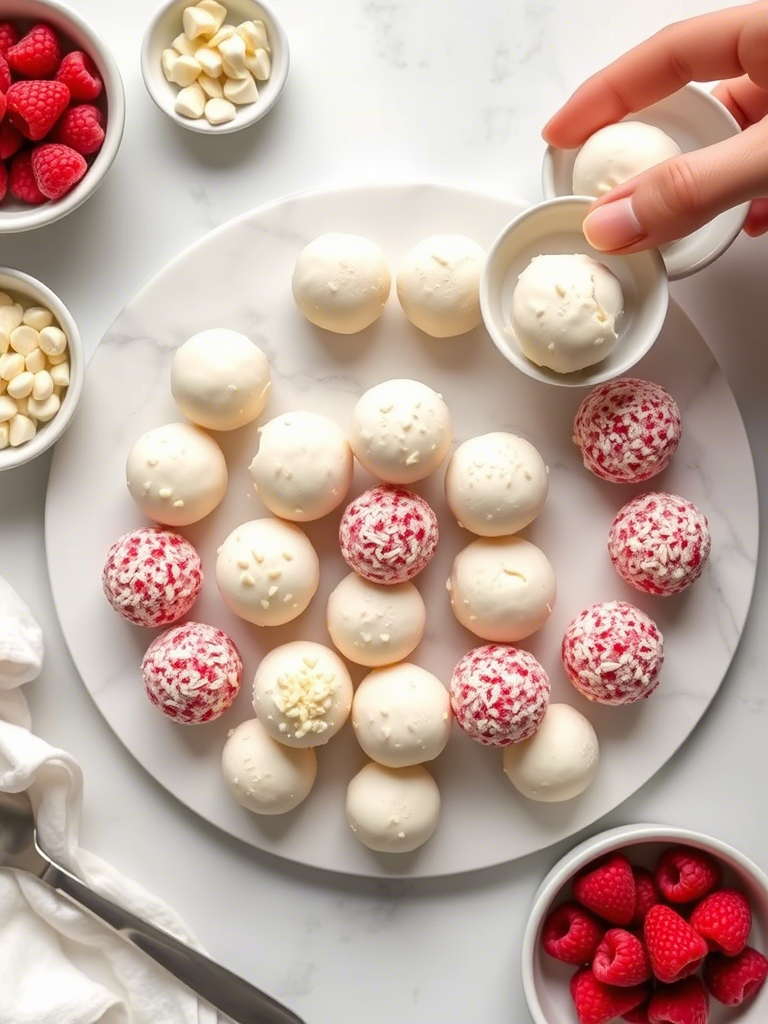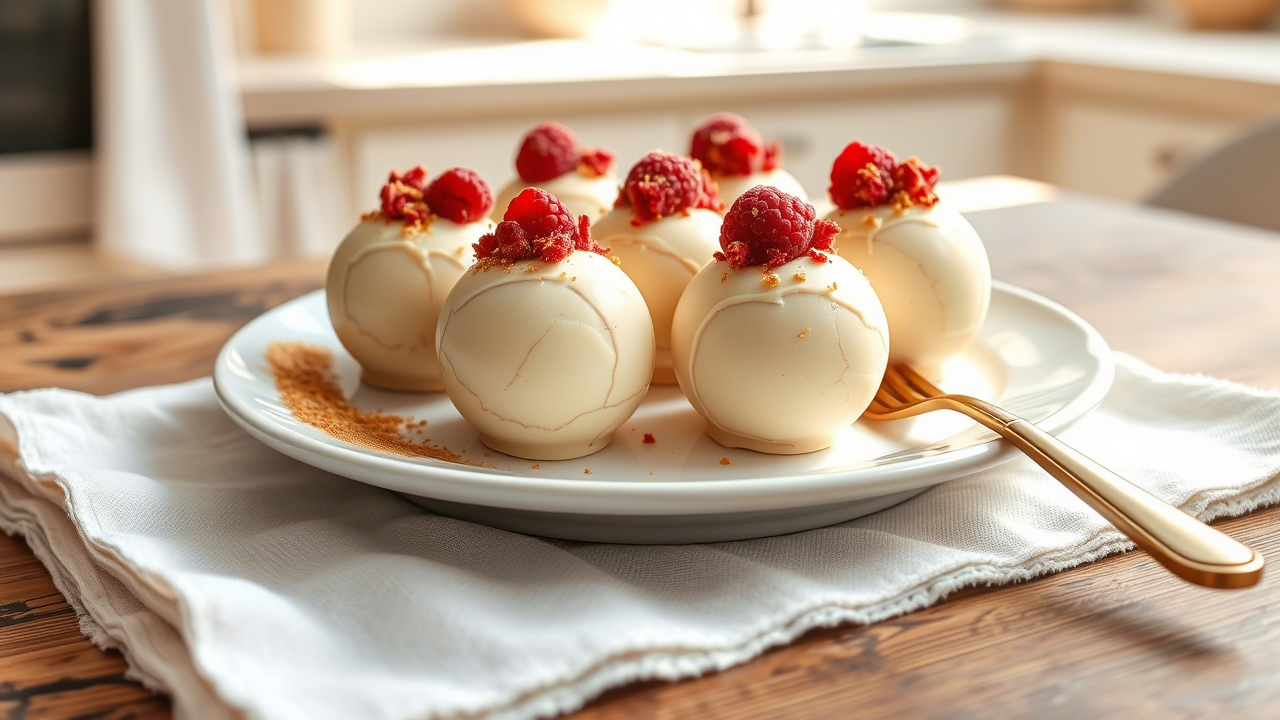There’s something a lil’ dangerous about food that fits in the palm of your hand. It seduces you into thinking one bite couldn’t possibly matter. But let me tell you—these White Chocolate Raspberry Cheesecake Balls? They hit like a freight train made of sugar, fat, and brilliance. They’re not just dessert; they’re the pastry chef’s answer to edible engineering.
Now, this article isn’t for the faint of heart. It’s not a Pinterest repost or a grandma’s fridge-magnet recipe. This is a deep dive, a no-fluff, professionally informed breakdown of what it takes to craft this trending treat from a chef’s lens. You want to serve this at a five-star dessert tasting or sell them at $6 a pop in an upscale patisserie? Then read on, we got things to unpack.
What Exactly Are White Chocolate Raspberry Cheesecake Balls?
These little spheres are bite-sized, no-bake (usually), rich cheesecake bites enrobed in high-quality white chocolate, often with a raspberry swirl or purée core. Think truffle meets frozen cheesecake pop meets an afternoon you’ll never forget.
They’ve been blowing up in boutique bakeries and Instagram food reels lately. You’ve seen them. Smooth, glossy shells. Delicate freeze-dried raspberry dust on top. A cross-section that oozes soft, tart filling. It’s sensory warfare—and it works.
Professionals love them because they offer big flavor in a small, manageable, portion-controlled format. Consumers love them because they’re a guilt-optional indulgence that looks like art and tastes like sin.
The Foundation: Cheesecake Filling That Doesn’t Mess Around
Let’s talk filling first. If your cheesecake mix ain’t balanced right, everything else collapses.
Classic no-bake cheesecake base = cream cheese + powdered sugar + heavy cream. But that’s just your canvas. For white chocolate raspberry balls, we’re looking at something silkier. More luxurious.
Top-tier versions fold in melted white chocolate into the filling itself. That adds not just flavor, but texture—giving the center that dense-but-creamy structure that holds up once frozen but melts in the mouth.
Cream cheese should be full-fat. Don’t even look at light versions unless you wanna weep silently into your bain-marie later.
Raspberry? You’re not just dumping jam in there. Ideally, you want a concentrated raspberry reduction or a purée with seeds strained out. Stirred into the mix as a swirl—or piped as a center core like a bonbon filling.
Pro tip: a 2:1 ratio of white chocolate to raspberry purée in the core keeps it tart without overpowering the base.

The White Chocolate Shell: Not All Chocolates Are Created Equal
Let’s cut to the chase. Most white chocolate sucks. It’s sweet and waxy with about as much nuance as a greeting card poem. But use real couverture white chocolate with at least 30% cocoa butter and suddenly—boom—you’re in the realm of professionals.
Brands like Valrhona’s Ivoire or Callebaut’s Velvet give you that snappy, creamy, well-tempered shell that doesn’t turn grainy or greasy when chilled.
Tempering is non-negotiable. Skip it, and your shells bloom or crack. For those unfamiliar: tempering means manipulating chocolate’s temperature through a curve (typically 45°C to 27°C to 30°C for white chocolate) to align cocoa butter crystals. Yes, it’s nerdy. But it’s the line between pastry intern and executive chocolatier.
You can dip frozen balls or mold your shells first, filling them after. Dipping is easier, molding is cleaner. Depends how many you’re doing. Small batch? Dip. High production? Mold with polycarbonate truffle shells.
Raspberry: A Flavor That Needs Taming
Raspberry is fierce. Sharp, sour, assertive. In a cheesecake bite, that can be a blessing or a disaster.
The trick is not just balance, but dimension. Don’t just use one note of raspberry. Layer it. Here’s what the pros do:
- Raspberry reduction in the center.
- Freeze-dried raspberry powder on the shell.
- Optional: tiny pieces of candied raspberry or raspberry liqueur for accent.
That layering? It builds complexity. You get a whisper in the first bite, a punch in the middle, and a lingering finish on the back palate.
Use a splash of Chambord or raspberry vinegar to add brightness. I once saw a chef infuse her cream with dried hibiscus for extra acidity—wild, but it worked.
Texture Is King: The Crunch Factor
Now here’s where a lot of these go wrong. Soft shell. Soft middle. Soft… everything. Boring.
We want contrast. Professionals achieve this in sneaky ways:
- A biscuit crumb base folded into the cheesecake mix.
- Crispy pearl sugar inside for a surprise crunch.
- Toasted coconut or pistachio on the outer coating.
Even layering a thin layer of graham cracker inside the shell (before filling) gives structure. Sounds finicky? It is. That’s why your version will taste like pastry school sorcery while theirs tastes like supermarket guilt.

Storage, Shelf Life, and Selling Them Right
Here’s a fun fact: because they’re frozen or chilled, these cheesecake balls are incredibly shippable. And with the rising popularity of e-commerce desserts (check Goldbelly’s data—dessert orders were up 42% last year), this is a product worth scaling.
Shelf life? About 7 days refrigerated, 2 months frozen if sealed well. Chocolate bloom is the enemy here. Always vacuum seal or use desiccant packs to maintain integrity during shipping.
Want to package these for high-end retail? Think inside velvet-lined rigid boxes with individual paper cups. Or clear acetate boxes with gold foil stamping. The appearance should match the experience.
Real-World Case Study: Dominique’s Dessert Lab in NYC
Take “Dominique’s Dessert Lab” in Brooklyn. They started selling white chocolate raspberry cheesecake balls in 2022. Small batch. $5 each. Hand-finished with edible rose petals and micro-gold leaf.
They sold out every weekend.
Six months in, they shifted to a pre-order model and partnered with a local wine bar to offer them as dessert pairings. Sales doubled. They’re now expanding into wholesale supply for boutique grocers across the Tri-State.
Why did it work? Smart flavors. Sharp branding. Consistency.
Common Missteps and How to Dodge Them
Let’s break down some rookie errors that even trained chefs make:
1. Over-whipping the filling
Once you whip in air, freezing expands it. Result? Crumbly centers. Always mix until just combined.
2. Cheap white chocolate
Already said it, but I’ll die on this hill. Cocoa butter content matters. Go cheap, and you’ll end up with grease sticks.
3. Under-freezing before coating
Balls must be rock-solid before dipping. If not, the chocolate seizes and shells crack like old plaster.
4. One-note raspberry
Don’t rely on jam. Go deeper. Infuse, layer, and experiment.
5. No portion control
These aren’t cake pops. They’re gourmet bites. Keep ‘em at 20–25g each. That’s where the texture and flavor balance shine.
Are They Just a Trend or a Mainstay?
Food trends are weird beasts. Some burn hot and vanish (cronuts, anyone?). But white chocolate raspberry cheesecake balls are showing more staying power.
Why? They hit three hot zones:
- Customizable base for endless variations (matcha-mango, lemon-blueberry, you name it)
- Instagrammable design
- Ideal for individual or scalable production
Even frozen dessert conglomerates are taking notes. Nestlé filed a patent for a “cheesecake bite with dual fruit layer” in 2024. Coincidence? Hardly.
The Chef’s Cheat Sheet: Key Takeaways
- Use full-fat cream cheese and real white chocolate (30%+ cocoa butter)
- Layer raspberry flavor for dimension and balance
- Texture contrast is crucial—add crunch, don’t rely on just softness
- Always temper chocolate for perfect shells
- Keep balls at 20–25g for premium mouthfeel
- Market them like couture desserts, not homemade truffles
Final Thoughts: Tiny Dessert, Big Opportunity
The magic of White Chocolate Raspberry Cheesecake Balls isn’t just in how they taste. It’s in how they fit perfectly into what modern customers want—small indulgences, big flavor, and beauty that bites back.
For professionals in the culinary field, this isn’t just another dessert. It’s a scalable, customizable, profitable format that blends classical technique with contemporary flair.
So next time someone calls them “just little cheesecake balls,” smile politely. Then go back to selling out your next 200-batch run.
FAQs
What are White Chocolate Raspberry Cheesecake Balls?
They’re bite-sized no-bake cheesecake treats with a raspberry core, coated in tempered white chocolate.
Do they need to be baked?
Nope, they’re typically no-bake and set in the fridge or freezer.
What type of white chocolate should I use?
Always use couverture white chocolate with 30%+ cocoa butter for proper tempering and taste.
Can I use raspberry jam instead of purée?
Technically yes, but it’ll lack depth—go for a concentrated purée or reduction instead.
How do I prevent the chocolate from cracking?
Make sure the cheesecake balls are fully frozen and the chocolate is properly tempered.
What size should each ball be?
Aim for 20–25 grams each for ideal texture, flavor balance, and portion control.
How long do they last in the fridge or freezer?
Up to 7 days refrigerated, and about 2 months if frozen and sealed properly.
Can I scale this for commercial production?
Yes, and they’re perfect for retail, e-commerce, and upscale catering menus.
What’s the best way to add texture contrast?
Incorporate crispy elements like biscuit crumbs, toasted coconut, or sugar pearls.
How do I make them visually appealing for sale?
Use glossy tempered chocolate, decorative powders, edible gold, and premium packaging.

Mariana is a passionate home cook who creates delicious, easy-to-follow recipes for busy people. From energizing breakfasts to satisfying dinners and indulgent desserts, her dishes are designed to fuel both your body and hustle.
When she’s not in the kitchen, she’s exploring new flavors and dreaming up her next recipe to share with the Foodie Hustle community.

